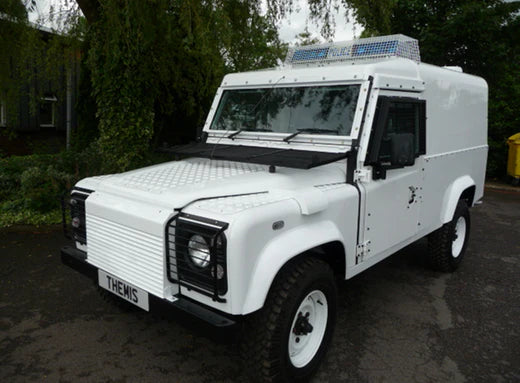Hobson Industries Armouring is a Division of Hobson Industries, the Lincolnshire, UK based lightweight armour specialists, announce the launch of THEMIS, a lightweight armour system developed directly for use on lightweight 4x4 vehicles.
THEMIS Characteristics for a lightweight and a highly mobile blast and ballistically capable vehicle complete with through life support are:
- The appliqué armour system addresses many of the problems associated with current hard armour systems. THEMIS at 50m² on new vehicles is the lightest Stanag 1 and PAS300 tested and certified blast and ballistic system in service and is well within the GVW.
- The ballistic glass system is also unique being of cassette design and although it forms part of the armour system, damaged transparent armour can be replaced in the field in minutes.
- The blast protection system is also a Hobson innovation and captures event projectiles and absorbs and deflects the blast shock wave. It is well in excess of Stanag 1 and PAS300 requirements.
- There is no welding requirement on the vehicle. The THEMIS armour system© is fully repairable either through RTA or enemy action.
- The THEMIS family is fully through life supportable for an expected 8 – 10-year service life and is upgradable at half-life within its pod structure capability to meet new threats.
- The appliqué armour for post fit has a simple attachment system and is on the principle that the vehicle is fitted for but not with a THEMIS appliqué system to achieve vehicle ballistic upgrade.
- A gun mount THEMIS protection shroud is in development and this will be shown on Hobsons’ stand at the DVD event.
- A new pod system with lightweight structural and ballistic integrity is also in development with outstanding results, the goal being full AP integrity. The INEOS Automotive Grenadier with its 4-tonne armour ready chassis is one of the vehicles of choice for the future.
- THEMIS has been tested against M193, SS109, M855, M80 Ball, 7.62 x 51 L40A1, 62 x 39 API, 7.62 x 54R Iron Core and a range .308 and .223 rounds. None penetrated the THEMIS armour system.
- The enhanced STORM chassis was to play a significant role for the future of Land Rover armoured vehicles in military service having been taken up by the Ministry of Defence when upgrading the SNATCH 2. These are now being re-purposed with further upgrades for an alternative use using the THEMIS armour system© as full Stanag 1 armour protected vehicles.
- The THEMIS armour system© is being fitted on to a Land Rover WMIK platform which forms the basis of Hobsons’ Gunship with the resultant weight saving making the traditional WMIK platform a high mobility vehicle as it was originally intended.
The weight reduction using THEMIS armour system© gives the opportunity for an electric drive train for covert and stealth operations. The electrification of the Land Rover WMIK is currently under development by Hobsons with its drive train partner.
- A new gun system is being integrated and remains well within the gross vehicle weight.
The re-purposed and upgraded and ballistically protected CAV 100 SNATCH and Land Rover WMIK Gunship platforms fitted with the THEMIS armour system© will be on display on Hobson Industries stand OR-35 on the Off Road Centre at the MoD DVD Exhibition being held at Millbrook Proving Ground on the 21st and 22nd September 2022.
Peter Hobson, Managing Director of Hobson Industries said, “Protection of light 4x4 vehicles on the battlefield has often been hampered by payload issues, thus armour and protection is limited to providing a vehicle with the protection and mobility within these parameters. Wars and conflicts show that cunning adversaries use overmatch techniques to defeat these protection systems to destroy these vehicles and their occupants on the battlefield. The harrowing photographs of soldiers and their vehicles being decimated by IEDS in Iraq and Afghanistan created a rush by the Allied Forces to produce a range of light vehicles with adequate protection for their occupants. The development of the THEMIS Armour System© can be traced back to the Northern Ireland conflict of the early 1990s.”
The THEMIS Armour System©
The base point for THEMIS is the SNATCH VIXEN CAV 100 S2 glass pod (or similar product), protected with a much-reduced thickness of high hardness steel. Previously the .556 and M193 rounds traditionally took more than 8mm of high hardness armoured steel to achieve. Peter’s knowledge of the physics associated with the ballistic event and the broad understanding of the properties of ballistic materials set about finding a lightweight ballistic protection system. This has been achieved at Stanag Level 1+ at around 50kg m² with the THEMIS armoured pod system and is probably lightest armoured lightweight vehicle in use at this time. The system can also be fitted as an appliqué system for upgrades to current in-service vehicles.
The THEMIS development caught the eye of a UK Government customer and Hobsons was tasked to supply a test vehicle for evaluation. The vehicle was independently ballistically and blast tested to PAS300 methodologies. Vehicle handling characteristics have also been independently validated and certified to PAS301.
“The THEMIS system is a quantum leap in ballistic event management with appliqué armour at around 20.kg² on a CAV100 SNATCH pod upgrade and as a full ballistic solution to Stanag Level 1+ at around 50kg² for new vehicles. The THEMIS armour system© is a result of a combination and understanding of ballistics, physics and knowledge of materials in integration and this opens up areas of ballistic management protection solutions to both new vehicle design and post design for existing in-service light armour protected vehicles.” Peter Hobson continued.

